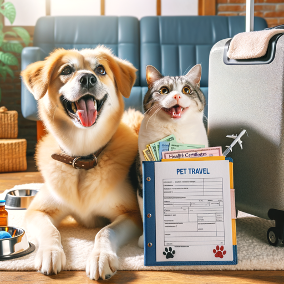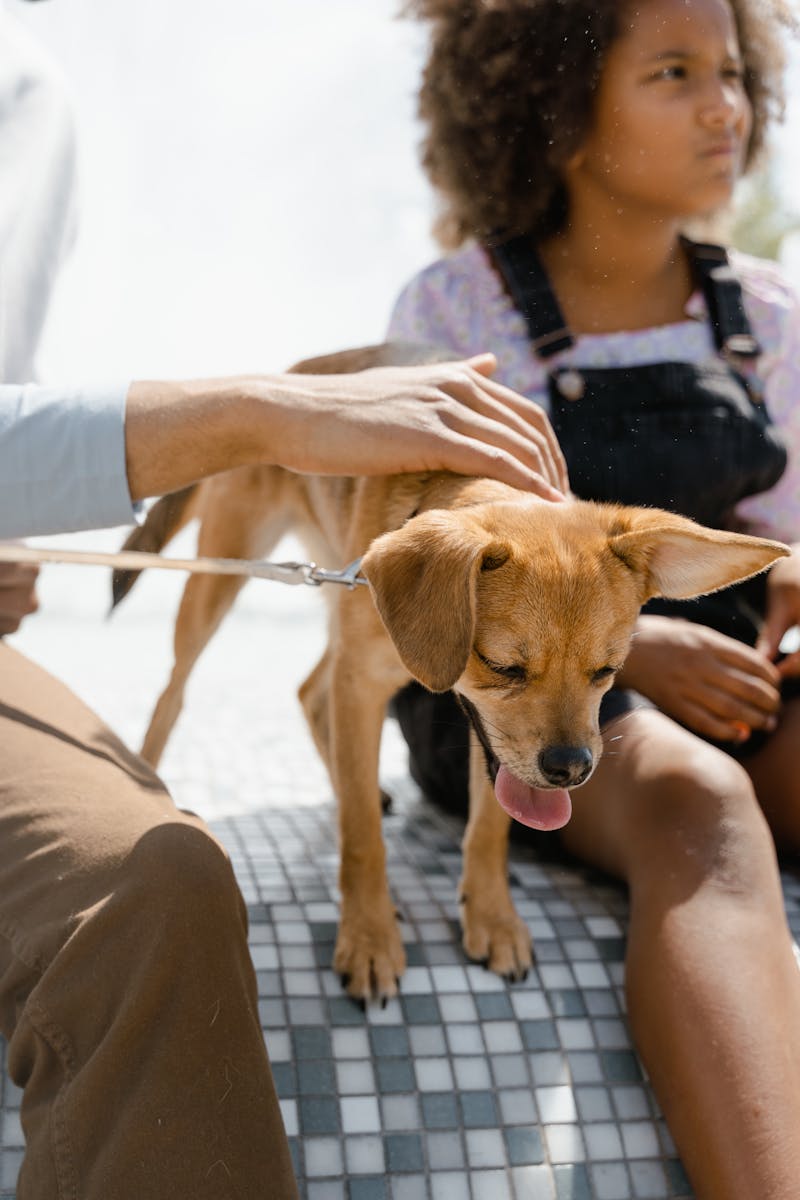Traveling with Pets: Legal Considerations for Road Trips and Flights
Traveling by Car with Pets: Essential Legal Considerations and Safety Tips
Hitting the open road with your furry companions can be an exciting adventure! However, before you buckle up, there are essential legal considerations and regulations to keep in mind to ensure a smooth journey. In this post, we’ll explore pet safety measures and state-specific laws to make sure you and your pet enjoy your travels without any hiccups.
Essential Pet Safety Measures
Safety should always be a top priority when traveling with pets. Here are some vital precautions to take:
- Secure Restraint: Just like humans, pets should be safely restrained in the car. Use a pet seatbelt, harness, or a carrier to keep them secure. This not only protects your pets but also prevents distractions while driving.
- Climate Control: Make sure your vehicle is comfortable for your pets. Never leave your pet alone in a parked car, especially in hot weather, as temperatures can rise quickly and lead to heatstroke.
- Take Breaks: Plan regular stops to allow your pet to stretch, use the bathroom, and hydrate. This helps prevent restlessness and can make for a happier, calmer journey.
Understanding State-Specific Laws
Did you know that some states have specific laws regarding traveling with pets? Here are a few examples:
- Animal Restraint Laws: Some states, like New Jersey and California, have laws requiring pets to be restrained while traveling. Failing to do so can result in hefty fines.
- Rabies Vaccination: Many states require pets to be up-to-date on their vaccinations, particularly rabies. Always carry proof of vaccination while traveling to avoid any conflicts with law enforcement.
- Pet-Friendly Lodgings: If you’re planning to stay overnight during your journey, check your destination’s pet policies. Some hotels and accommodations have restrictive rules, so doing your research in advance can save you from a last-minute scramble.
Conclusion
Traveling by car with your pet can be a rewarding experience with the right preparations. By keeping safety measures in mind and understanding the laws that affect your journey, you can create a stress-free environment for both you and your furry friend. So, before you hit the road, make sure your pet is safe and that you’re informed about local regulations!

Airline Regulations for Pet Travel: Carrier Requirements, Fees, and Documentation
Traveling by air with your pets can be a mixed bag of excitement and anxiety. While it opens up new horizons that a car journey can’t match, navigating the airline regulations regarding pet travel is crucial for a smooth experience. Let’s break down what you need to know about carrier requirements, fees, and the necessary documentation for flying with your furry friends.
Carrier Requirements
Airlines have specific requirements for pet carriers that must be met for your pet to travel safely and comfortably. This typically includes:
- Size and Dimensions: Ensure your carrier meets the airline’s size restrictions. Usually, it should be well-ventilated and secure with sufficient room for your pet to stand, turn around, and lie down comfortably.
- Type of Carrier: Most airlines require soft-sided carriers if your pet is traveling in the cabin. For larger pets traveling in cargo, hard-sided carriers that comply with International Air Transport Association (IATA) regulations are typically necessary.
- Labeling: Make sure to clearly label your pet’s carrier with your contact information, including your name, phone number, and destination address.
Fees for Traveling with Pets
Be prepared for additional travel costs when making plans to fly with your pet. These can vary widely between airlines, so check their policies beforehand. Typically, you can expect:
- Cabin Fees: If your pet will be traveling in the cabin with you, anticipate a fee ranging from $75 to $250, depending on the airline and route.
- Cargo Fees: For pets traveling in the cargo hold, costs can range from $150 to over $500, depending on the size and weight of the pet and the carrier.
- Additional Fees: Some airlines may charge extra for services like feeding or use of private EMS in the case of special needs pets.
Necessary Documentation
Before flying, make sure you have all the necessary documents in place to avoid any last-minute stress. Important paperwork includes:
- Health Certificates: Most airlines require a health certificate issued by a veterinarian within 10 days of travel. It confirms your pet is healthy and fit to fly.
- Vaccination Records: Keep updated vaccination records handy, especially for rabies and other prevalent diseases, as they may be requested at check-in.
- Import Permits: If you’re traveling internationally, research and obtain any import permits required by your destination country—this can vary widely based on local regulations.
Understanding airline policies and preparing in advance for your pet’s travel needs can make flying a much more enjoyable experience for both you and your furry companion.

Health and Vaccination Requirements
Traveling with pets isn’t just about car safety and understanding state laws; it’s also crucial to pay attention to health certifications and vaccination requirements. Whether you’re heading to a neighboring state or planning an international getaway, keeping your pet’s health records updated is vital for a smooth journey.
Health Certifications for Your Pet
When crossing state lines or traveling abroad, various states and countries may require health certificates for your pets. These certificates, usually issued by licensed veterinarians, confirm that your pet is healthy and up-to-date on vaccinations. Here are a few things to consider:
- Interstate Travel: Most states require a health certificate issued within a specific time frame (usually 10 days) before travel. An updated rabies vaccination record is often part of this requirement, which could prevent any surprises during border checks.
- International Borders: Travel outside the U.S. can be more complex. Some countries may require specific vaccinations (like rabies and distemper), parasite treatments, and even a quarantine period. Checking the specific health requirements of your destination well in advance is essential.
Vaccination Requirements
Keeping vaccinations up-to-date is not just about legal compliance; it’s crucial for your pet’s health, especially when exposed to different environments. Some essential vaccinations include:
- Rabies: Nearly all states require pets to be vaccinated against rabies, and this is often enforced when traveling across state lines. Always carry proof of vaccination.
- Distemper and Parvovirus: These vaccinations are important, particularly if you’ll be visiting areas frequented by other pets, like parks or pet-friendly hotels.
- Leptospirosis: If you’re traveling to regions known for standing water or rural areas, consider discussing the leptospirosis vaccine with your vet.
Keeping Health Records Updated
An often-overlooked aspect of pet travel is keeping health records organized and easily accessible. Here are some practical tips:
- Create a Pet Travel Folder: Compile your pet’s vaccination records, health certificates, and any necessary medications in a designated folder. This will make it easy to show proof when required.
- Use Digital Records: Apps and digital storage options can help keep your pet’s health records handy. A simple snapshot of vaccination documents is often sufficient.
- Regular Vet Visits: Schedule routine check-ups with your veterinarian, particularly before travel, to ensure your pet is healthy and their vaccinations are current.
Conclusion
Traveling with your furry companion can be a joyful experience, but ensuring that health certifications and vaccinations are in order will make it far less stressful. Keeping your pet’s health records updated helps to comply with laws and ensures the safety of your beloved pet. So, before you embark on your road trip or international adventure, verify that all health requirements concerning your pet are met.

Planning Your Route: Choosing Pet-Friendly Paths and Accommodations
When embarking on a road trip with your beloved pet, planning the right route and identifying suitable accommodations can make all the difference in ensuring an enjoyable experience for both you and your furry friend. Here are some essential tips for selecting pet-friendly routes and places to stay along your journey.
Finding Pet-Friendly Routes
- Utilize Pet-Friendly Travel Searches: Several travel websites and apps cater specifically to pet owners, helping to identify pet-friendly routes. Websites like BringFido and Rover not only provide information on accommodations but also help you find parks and rest areas where your pet can stretch their legs.
- Check for Pet-Friendly Stops: Aim to include stops at parks, rest areas, or pet-friendly restaurants along your route. Planning breaks every few hours is ideal to allow your pet to relieve themselves and get some exercise before continuing on the road. Google Maps can be handy in searching for pet-friendly parks along your route.
- Consider Scenic Backroads: Instead of taking the fastest route, consider scenic backroads that may offer more opportunities for pet-friendly stops. Not only are these routes generally more enjoyable, but you may also discover hidden parks or pet-friendly attractions that can make your trip even more memorable.
Finding Pet-Friendly Accommodations
- Research Before You Reserve: Always confirm accommodations’ pet policies before booking. While many hotels advertise as pet-friendly, they may have restrictions on certain breeds or sizes. Look for accommodations that explicitly state they welcome four-legged guests, like La Quinta Inn & Suites or Kimpton Hotels, which are known for their broad pet policies.
- Read Reviews from Other Pet Owners: Online platforms like TripAdvisor or Yelp can provide valuable insights. Look for reviews from pet owners who have stayed at the accommodations. This can help you gauge how accommodating the staff is regarding pets and whether they have suitable amenities like dog parks or pet walking areas.
- Ask About Nearby Pet Areas: Upon arriving at your accommodation, ask the staff about nearby pet areas where your furry friend can run and play. Some hotels may have their own designated pet areas, while others might be just a short drive from local dog parks.
Incorporating Pet Breaks During Long Trips
- Plan for Frequent Breaks: During your trip, it’s essential to factor in regular breaks to allow your pet to stretch their legs, use the bathroom, and quench their thirst. It’s also a great chance for you to stretch your legs and relax, too!
- Stay Aware of Local Laws: Be mindful of leash laws and pet policies in the areas where you plan to stop. Some locations may require pets to be kept on leashes, while others offer off-leash areas. Understanding these laws can help prevent unwanted interruptions to your journey.
- Pack Pet Travel Essentials: Ensure you have everything you need for your pet during your stops: water bowls, food, waste bags, and perhaps their favorite toy – it can help keep your pet comfortable and secure during the trip.
Traveling with your pet can be an enriching experience with the right planning and consideration of pet-friendly routes and accommodations. By following these tips, you can create not only a humane and safe trip but also a memorable adventure that you and your furry companion will cherish for years to come!

Preparing for Emergencies: Being Ready When Traveling with Pets
While the thrill of traveling with your furry friends can be exhilarating, it’s crucial to prepare for unexpected emergencies. Planning ahead can make a world of difference when it comes to your pet’s safety and well-being. Here are some key considerations to ensure you’re ready for any situation that might arise on the road.
Understanding Your Legal Responsibilities
You may know the basic pet travel laws, but it’s essential to understand your legal responsibilities in case of an emergency. Some states have specific regulations concerning the welfare of animals during transportation. For example, if an accident occurs and first responders are involved, it’s critical to have appropriate paperwork, such as vaccination records and proof of ownership, readily available. Additionally, be aware of local leash laws and any requirements for pet containment during emergencies.
Creating an Emergency Kit
An emergency kit is your best friend when traveling with pets. Here are some items to include:
- First Aid Supplies: Bandages, antiseptic wipes, and tweezers can help manage minor injuries.
- Medications: Carry any necessary prescriptions, alongside a copy of your pet’s medical records.
- Food and Water: Pack extra food and portable water bowls. Don’t forget a can opener for canned food!
- Identification: Ensure your pet has a collar with an ID tag and a microchip, if possible.
- Comfort Items: Familiar toys or blankets can help ease your pet’s anxiety during stressful situations.
Having this kit available can make it easier to address any health concerns or emergencies quickly and efficiently.
Knowing Nearby Veterinary Services
Before your journey, research veterinary services along your travel route. Create a list of veterinary clinics, emergency animal hospitals, and animal poison control hotlines relevant to your destination. Apps like VetFinder can help you locate nearby pet services in real-time—an invaluable tool if you find yourself in a pinch.
Moreover, just as you would familiarize yourself with local hospitals and emergency services for humans, doing the same for your pets can provide peace of mind. Don’t hesitate to call ahead to check their hours of operation, as well as any special requirements they may have for pets during emergencies.
Conclusion
By taking the necessary steps to prepare for emergencies while traveling with your pets, you can ensure a safer and more enjoyable journey. Be aware of your legal responsibilities, pack an emergency kit, and know where to find veterinary services along your route. These proactive measures will help safeguard your furry friends and give you peace of mind while exploring new places!
news via inbox
Nulla turp dis cursus. Integer liberos euismod pretium faucibua





